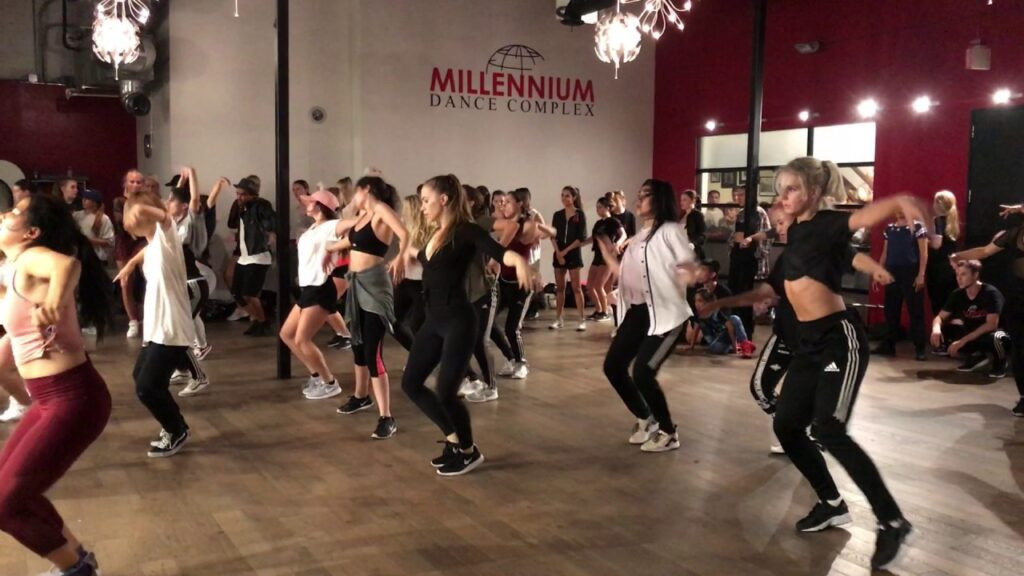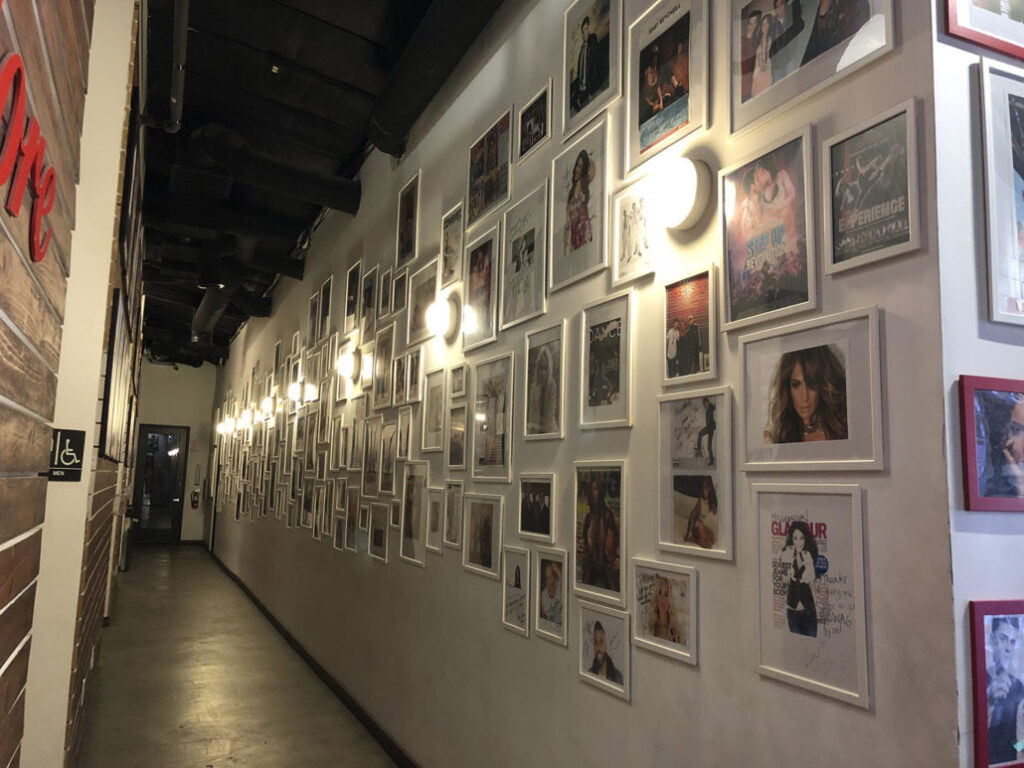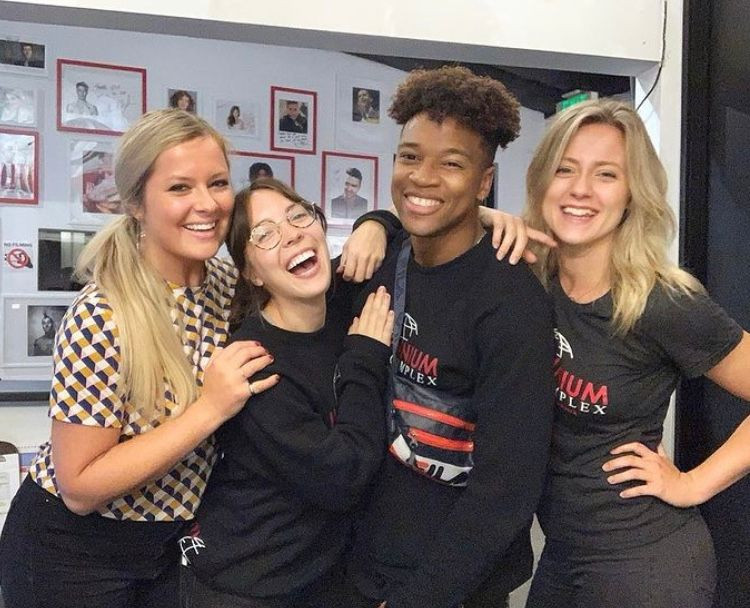Growing up, like many aspiring dancers, my screen time was dominated by YouTube videos showcasing incredible talent training and perfecting their moves against the iconic red walls of Millennium Dance Complex in Los Angeles. It wasn’t just a studio; it was a beacon, a symbol of dance excellence.
Visiting LA for the first time in 2015, I experienced firsthand the almost sacred reverence dancers hold for these studios. The energy was palpable, the history tangible. Fast forward to early 2019, and I found myself working as a work-study at Millennium Dance Complex. It quickly became more than just a job; it became my home, deeply woven into my dance journey.
 Dancers at Millennium Dance Complex in Los Angeles
Dancers at Millennium Dance Complex in Los Angeles
Unpacking the Millennium Dance Complex Phenomenon
To the uninitiated, Millennium Dance Complex might seem like just another dance studio on Ventura Boulevard. However, dismissing it as “just a dance studio” would be a profound understatement. It’s a global phenomenon, a thriving hub of dance culture, and a significant business, especially during the summer months when classes are routinely sold out, buzzing with energy and ambition.
The Los Angeles location boasts two primary studios for classes, accommodating up to 111 and 75 students respectively. Beyond classes, four additional studios of varying sizes are available for rent, catering to rehearsals and private sessions.
Since 2011, Millennium Dance Complex has expanded its reach as a franchise, establishing studios across the globe. You can find Millennium’s vibrant dance atmosphere in Toronto, Beijing, Germany, Tokyo, Shanghai, Brazil, and multiple locations across the U.S. Yet, the Los Angeles studio remains the “O.G.”, the original and arguably the most iconic location, drawing dancers from every corner of the world.
The Unique Allure: Experiencing Millennium for the First Time
My absolute favorite aspect of working at Millennium Dance Complex is witnessing the sheer awe and inspiration on the faces of dancers experiencing the studio for the very first time. They step in, often slightly intimidated, undeniably overwhelmed, yet buzzing with excitement. The walls adorned with photos of dance legends – Michael Jackson, Britney Spears, Beyoncé, Justin Timberlake, and Justin Bieber, among countless others – serve as a powerful testament to the studio’s legacy.
For some, the experience is so profound it brings them to tears. While some might consider it “just a dance studio,” these emotional reactions highlight the deep connection dancers feel to Millennium. Witnessing their excitement reignites my own gratitude for being part of this incredible space.
Guiding newcomers through the studios, explaining class procedures – routines that have become second nature to LA dancers – is a truly rewarding part of my role. Despite language barriers, a smile and enthusiastic body language bridge the gaps, creating a welcoming environment for dancers from all backgrounds.
A Week in the Life: Work-Study Duties at Millennium
The work-study program at Millennium Dance Complex involves one shift per week, either 9 AM to 4 PM or 4 PM to 11 PM. Each shift includes a manager, a register, and two runners, each playing a vital role in keeping the studio running smoothly.
Manager: The studio office is the manager’s domain. They handle emails, manage the certificate program students, and oversee the overall operation of the studio, ensuring everything runs efficiently. They are the go-to person for any significant issues.
Register: Stationed at the front desk, the register handles all financial transactions, including class payments and studio rentals.
Runner: As the name suggests, runners are dynamic and proactive, handling a wide range of practical tasks essential to the daily functioning of Millennium.
 Work-study team at Millennium Dance Complex
Work-study team at Millennium Dance Complex
Inside the Runner Role: Tasks and Responsibilities
The runner position is multifaceted and keeps you on your toes. Here’s a glimpse into the daily tasks:
-
Class Check-ins and Payments: Ensuring every dancer signs in and pays for their class at the front desk is the first crucial step.
-
Class Counts: At the start of each class, runners count the dancers in the studio – sometimes up to 111 energetic individuals – to verify class attendance against sign-ins. Discrepancies require tactful intervention, sometimes pausing the class to address unpaid attendees, which, while awkward, is necessary.
-
Roll Calls (When Necessary): If no one comes forward to pay after initial announcements, a roll call becomes necessary. This involves calling out names from the class list, a time-consuming process that disrupts the class flow but ensures fair payment.
-
Time Management with Signs: Maintaining class schedules is paramount. Runners use large cardboard signs to signal class endings 10 and 5 minutes prior. This might seem overly direct, but it’s essential to keep classes on time, as dancers deeply immersed in their practice can easily lose track of time.
-
Teacher and Choreographer Support: Teachers can bring up to five guests per class for free. Runners manage guest lists, provide water to instructors, communicate schedule updates, assist with sound equipment, and generally support the teachers’ needs.
-
Maintaining Studio Cleanliness: This includes restroom cleaning and trash removal – essential but less glamorous tasks that contribute to a positive studio environment.
-
Opening and Closing Procedures: Runners handle studio setup and shutdown, including turning on lights, speakers, air conditioning, and placing parking signs to prevent towing – all vital for daily operations.
-
Merchandise Sales: Millennium merchandise is highly sought after. Runners manage sales of hoodies, hats, t-shirts, and other items, tapping into the dancers’ love for studio apparel.
-
Rental Management: Accurate rental booking is critical. Runners handle phone inquiries and meticulously schedule studio rentals to avoid double-bookings, which could disrupt important rehearsals.
-
Answering Constant Inquiries: From “Can I speak to Justin Bieber?” to practical questions about class schedules and auditions, runners handle a wide range of phone inquiries, requiring patience and quick answers.
-
Substitute Teacher Coordination: Creating the class schedule is a weekly task. Given that many teachers are working professionals with fluctuating schedules, finding substitute teachers is a frequent necessity. Runners contact teachers, confirm availability, and find suitable replacements, often needing to reach out to numerous instructors to fill a slot.
-
Masterclass Assistance: Masterclasses, taught by renowned choreographers like Yanis Marshall, Tricia Miranda, Kyle Hanagami, and Brian Friedman, are popular events. Runners manage sign-ins, stamp attendees, and organize lines, especially during busy summer periods when queues extend outside.
-
Additional Tasks: Beyond these core duties, runners handle numerous smaller tasks that contribute to the smooth operation of Millennium Dance Complex.
 Millennium Dance Complex Work Study Team
Millennium Dance Complex Work Study Team
The Rewards of Being a Millennium Dance Complex Work-Study
The work-study program offers invaluable benefits for aspiring dancers:
-
Unlimited Dance Classes: Work-studies receive unlimited regular classes (excluding masterclasses), removing financial barriers to consistent training at a top-tier studio.
-
Networking Opportunities: Daily interaction with a vast network of dancers, teachers, and choreographers provides unparalleled networking opportunities within the dance industry.
-
Industry Insight: Working behind the scenes offers a unique perspective into the operations of a major dance studio, providing valuable insights into the business side of dance.
-
Training Community: The work-study team trains together, fostering a supportive and motivating environment with built-in training partners.
-
Family Atmosphere: A strong sense of community and camaraderie develops among work-studies, creating lasting friendships and a supportive family within the dance world. This experience is echoed at other studios like Movement Lifestyle, highlighting the strong community aspect of these programs.
Why Work-Study is Ideal for International Dancers
For international dancers, especially those on O1-B artist visas, the work-study program is particularly advantageous. These visas, designed for dancers, restrict other forms of employment. As I explained during my interview with Director Jin Lee, cleaning bathrooms was a small price to pay for the opportunity:
“If I don’t have this job, I can’t live in LA. My O1-b visa allows me to dance, and only dance, so regular side jobs are not an option. This work-study, compensated with training, is a legal and essential pathway for me to afford to live and train in LA. Without it, returning to Europe would be my only option.”
The work-study program provides a legal and viable way for international dancers to sustain their training in Los Angeles.
 International dancer in Los Angeles
International dancer in Los Angeles
Essential Qualities for a Millennium Work-Study
Passion for dance training is the primary requirement, as the program is compensated with classes, not monetary payment. Beyond passion, key attributes include:
-
Efficiency and Ability to Work Under Pressure: The studio environment is fast-paced and demanding, requiring quick thinking and efficient task management.
-
Friendliness and Welcoming Demeanor: Creating a welcoming and positive atmosphere is crucial. Millennium is a community, not just a business transaction.
-
Problem-Solving Skills: From schedule conflicts to facility issues, work-studies need to be proactive problem solvers.
The role can be demanding, especially during peak hours with back-to-back classes and a constant stream of inquiries. However, for those who thrive in dynamic environments and are passionate about dance, it’s an incredibly rewarding experience.
Joining the Millennium Dance Complex Work-Study Team
Referrals are often the most effective way to get your foot in the door. Taking classes at Millennium and becoming a familiar face demonstrates your commitment and interest. Inquiring at the front desk about work-study openings is a direct approach. Hiring is often based on timing, becoming available when a current work-study departs. My own opportunity arose through a friend working at the front desk who recommended me to the director.
For those interested, you can find more information and the application form on the Millennium Dance Complex website: Millennium Work-Study Program.
Embrace the Millennium Dance Complex experience – whether as a student or a work-study, it’s a journey into the heart of contemporary dance culture.
